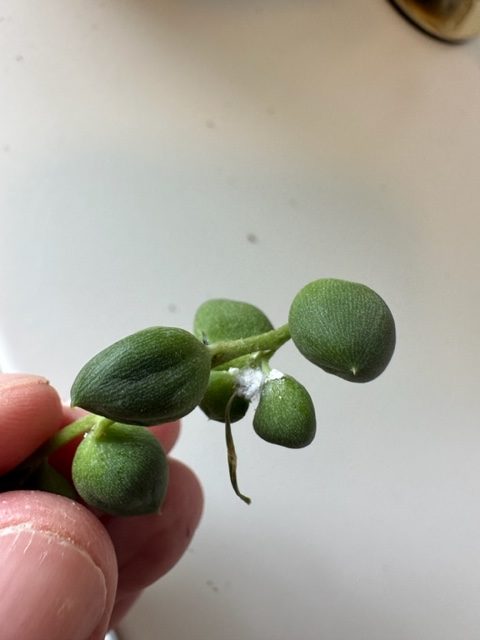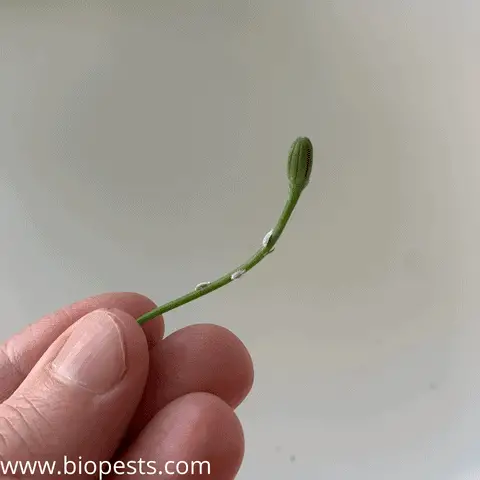Over the past few months, I have had the opportunity to renovate my office. I first thought: I am spending endless hours in this place; let’s fill it with plants and make the atmosphere more cheerful.
I decided to dedicate a corner just to succulent plants, and the string of pearls plant was the first one I bought. The second was the string of bananas, but I’ll discuss this in another article. I guess I am obsessed with weirdly shaped plants.
This plant has always fascinated me because of its unusual cylindric leaves that recall… a string of pearls, hence its name.
This beautiful plant is a succulent and belongs to the Asteraceae family. It is native to South Africa and looks good when grown in round hanging pots or balconies. It creates a beautiful cascading visual effect, given that its stems lengthen as they age and can exceed 3 feet (1 mt) in length!
Where Is the Best Place To Keep String Of Pearls Plant? Indoors or Outdoors?
The String of Pearls plant fits in our gardens, balconies, and home, provided we live in a country with a mild climate, such as zone 9. This plant loves the heat very much, and high temperatures do not scare it. On the contrary, it does not tolerate rigid temperatures: it should never be exposed to temperatures below 44 F (7 Celsius).

If grown outdoors, this plant should be placed in a place with plenty of bright, indirect light. This succulent does not do well if exposed to direct sunlight.
The String of Pearls plant thrives on neglect and works great for the beginner gardener since its spherical leaves act as small water reservoirs.
If placed indoors, it should be in a dry, luminous place. This plant fears moisture; therefore, placing it in a bathroom, for example, it would not be a good choice.
The string of pearls plant is beautiful on its own, even without flowers. Its spherical leaves have an intense and bright green color. In winter, the coloring of the leaves loses a little of its intensity.
When Does String Of Pearls Plant Bloom?
The String of Pearls plant blooms during the warmer months. This plant’s flowering period goes from August to the end of October (although, in some cases, plant nurseries and shops can stretch their blooming season till the first months of winter ).
The flowering period usually lasts for a month.
This beautiful succulent blooms with tiny white pom-pom-shaped flowers. The flowers are not very showy but have a delicate spicy scent.
Once the flowering period has passed, the flower produces its seeds which are waiting to be transported by the wind for the propagation of the plant.

Comics by AnatPlantz
How To Make String Of Pearls Plant Bloom?
To obtain a beautiful bloom from this plant, we must pay attention to two fundamental factors: water and light.
Water: Like any self-respecting succulent, you must not abound with water. Its spherical leaves are a water reservoir containing all the plant’s nutrients. The String of Pearls plant does not tolerate moisture and excess watering. You have to be especially careful with water stagnation. Keep in mind that the roots of this plant are not deep, so if you put the plant in a pot that is too big or too deep, you risk water stagnation.
For this reason, using a mixture of sand, peat, and perlite as soil is essential, allowing optimal drainage. To save time and effort, I like to use this cactus potting mix that is ready to go and hassle-free.
A word of caution: when I say that the string of pearls thrives on neglect… don’t take my word for it!
I know, I know, it sounds like a plant parent’s dream come true, but it can have devasting consequences! Let me tell you what happened to my plant. I was so worried about overwatering mine that I ended up practically starving it to death (my poor baby!). So, yes, give it water, but not too much. Trust me, with minimal effort, you can have a gorgeous string of pearls plant gracing your home!
This is a picture of my poor baby starving for water. I am truly sorry. The good news is that it recovered in a month or so.

Light: This plant loves bright environments and indirect light. It thrives when grown indoors, better if placed in front of a window. These plants can also be outdoors on balconies in countries with mild climates, provided they are not directly exposed to sunlight, which would undoubtedly damage the plant.

To guarantee a bloom during the warmest months, it is necessary to act during the winter and ensure that the plant enjoys as many hours of light as possible (which could be problematic in countries where there is not much sun in the winter).
Why My String Of Pearls Plant Is Not Blooming?
The main reasons your String of Pearls plant is not blooming are insufficient light and overwatering.
Remember to wait for the soil to dry out completely before watering (I wrote a whole article about soil drying. You can use the strategies for drying the soil faster, as indicated in this article). During the winter months, reduce the watering to a minimum.
Move your plant to a more luminous position.
Primary Diseases And Pests That Affect The String Of Pearls Plant
Root rot is undoubtedly the most common disease that affects the String of Pearls plant. The problem is always linked to stagnant water since the soil does not have time to dry between waterings.
In undrained soil, its roots remain in close contact with the water from the previous watering for too long, thus favoring rot and fungal diseases.
It would be best to be careful where you place the plant. Do not group this plant in the company of tropical plants that love humidity. If the surrounding environment is too humid, this could encourage fungal diseases such as powdery mildew. The latter will form a kind of anesthetic white patina on the stem and leaves. Check this article I wrote on how to take care of houseplants by spraying them with Alcohol.

Among the most common pests affecting the String of Pearls plant are aphids and scale. These tiny critters suck the sap off the young leaves, and if in large numbers, they can lead to a rapid deterioration of the plant and eventually to death. Although very small, they are visible to the naked eye as shown in this picture:

Unfortunately, I have inherited a colony of scale from the plant nursery!
When we buy new plants, we often forget to check that there are no parasites on the leaves. Fortunately, aphids and scale insects can be easily eradicated. In this article, I have described how to eliminate these pests with homemade preparations.
Is It Possible To Propagate String of Pearls Plant By Collecting And Germinating Its Seeds?
Sowing seeds is not recommended for propagating the String of Pearls plant. The whole process is just too slow and tedious.
Although the collection of the seeds of this succulent is relatively simple, the percentage of seeds that will germinate in the soil is meager. Besides that, it can take up to three months to see any results.

The easiest and fastest way to propagate this plant is by cuttings and not by seed.
however, just for your information, the seeds of this plant are contained within the flowers. Once dried, they can be harvested and planted in moist soil. You must keep an eye on the soil and ensure it never dries until the seed germinates.
How Fast Does String Of Pearls Plant Grow?
Proven the plant grows in optimal conditions, this succulent can grow from 4 to 15 inches (12 to 40 cm) per year.
How Long Does String Of Pearls Plant Live?
While this plant thrives in neglect, it’s not the kind of plant you can grow forever and forget. Unfortunately, a string of pearls plant has a rather short life, ranging from 3 to 5 years. The good news is that propagating the plant via cuttings is very simple, and it is advisable to do so to regenerate this beautiful succulent year after year.
To conclude, this plant is a must for anyone who wants to add an exotic touch to their home plant collection. It is pretty simple to grow, suitable for a beginner, and easy to propagate.
Satisfaction guaranteed!
Some of the links above are affiliate links, meaning I will earn a commission if you click through and make a purchase at no additional cost to you.
I Hope you enjoyed my post! You might also be interested in these articles:

